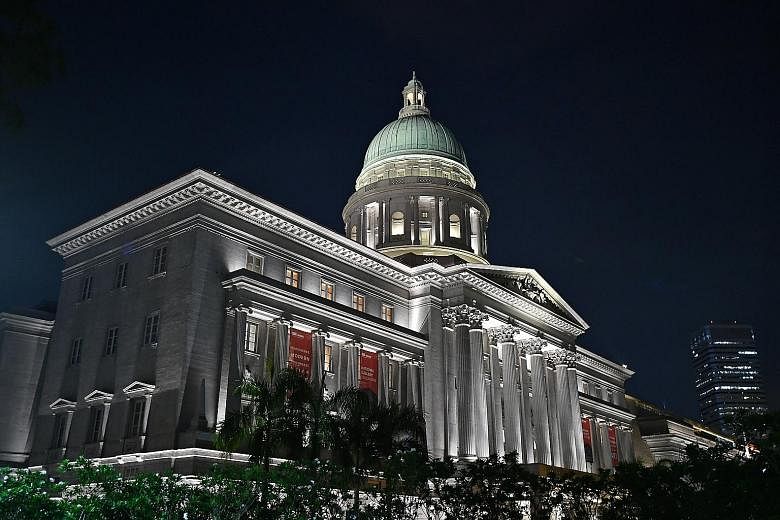It is a universally acknowledged truth that a country in possession of a First World reputation must also have a thriving arts scene.
But when it comes to paying for the arts, people are less quick to reach for the bill. And lately, the dreary economic climate means an increasing reluctance to open wallets.
The arts - which comprise theatre, dance, traditional arts, visual arts, music and literature - in Singapore are mainly funded by the state, unlike in other countries such as the United States, where they are largely supported through private donors and foundations.
In 2015, according to the Singapore Cultural Statistics report, 80 per cent of arts and heritage funding in Singapore, or $595.7 million, was provided by the Government through state agencies such as the National Arts Council (NAC).
This includes $79.4 million under the Cultural Matching Fund, which was set up by the Ministry of Culture, Community and Youth to match private cash donations to arts and heritage charities and Institutions of Public Character dollar for dollar.
The Government's support for the arts takes various forms, from grants and partnerships to industry facilitation and arts housing.
In the 2015/2016 financial year, for instance, $70.9 million was disbursed through the Grants Framework and $7.4 million through the Arts Housing Scheme, which was implemented in 1985 to provide affordable spaces to arts groups and artists.

An NAC spokesman said investing in the creation and appreciation of the arts "does not only add to the national canon of artwork we can be proud of, it also allows the arts on an individual level to entertain and inspire, and provide an avenue for self-expression, learning and reflection". "On a community and international level, the arts can connect our communities and position Singapore globally," the spokesman added.
-
2%
Percentage of donors in Singapore who had given to the arts.
16%
Percentage of people - among those who had not donated in the past 12 months - who would not consider giving to the arts at all.
-
About The Big Quiz

Each Monday, the paper's journalists address burning questions in the Opinion section, offering Singaporean perspectives on complex issues.
These primers form part of the outreach of The Straits Times- Ministry of Education National Current Affairs Quiz, or The Big Quiz, which aims to promote an understanding of local and global issues among pre-university students.
Underpinning this year's quiz is a timely focus on disruption, as various sectors and industries adapt to this global change.
The theme was featured in six campus talks helmed by editors and correspondents.
Six quiz rounds were also held for students to demonstrate their current affairs knowledge.
The six winning schools were Anglo-Chinese Junior College, Meridian Junior College, Nanyang Junior College, Dunman High School, Hwa Chong Institution and Pioneer Junior College.
The nationwide event is jointly organised by The Straits Times and the Ministry of Education, with the Singapore Press Holdings Foundation as its presenting sponsor.
•For more information or to view additional resources, go to https://www.straitstimes.com/tags/the-big-quiz
•For more information related to the topic, go to http://str.sg/4Dpo.
The remaining support for arts and culture comes from corporate sponsors and individuals.
Last year, donations in cash and kind to the arts scene fell by half to $64.7 million, down from $136.1 million in 2015.
The gap, said the NAC, was largely due to 2015 being an exceptionally prolific year for arts giving, thanks to Singapore's jubilee celebrations.
While corporate sponsors gave almost two-thirds less, individual contributions - which totalled $19.4 million - were double that of the year before. For the first time last year, contributions in kind, which included artwork loans and donations also peaked at $20.6 million.
Given the number of causes jostling for donors' attention, arts giving tends to fall behind. According to a survey on giving conducted by the NAC last year, 2 per cent of donors in Singapore had given to the arts.
The survey polled 1,035 individuals door to door from January to March last year, and 252 companies which had donated to various causes from October 2015 to April last year.
Most of the individuals surveyed cited low awareness as their reason for not donating, while a quarter said they had no interest in the arts.
Among those who had not donated in the past 12 months, 16 per cent said they would not consider giving to the arts at all, compared with 11 per cent for community and grassroots, and 10 per cent for religious organisations.
As for businesses, large local companies were most likely to support the arts, with 36 per cent preferring them over other causes, compared with 26 per cent for multinational corporations and 16 per cent for small and medium-sized enterprises.
The NAC said that while the state plays a critical role in sustaining the arts, it cannot achieve its mission alone. "The vibrancy in Singapore's arts scene today can be credited to the support of many generous corporate and individual donors who value the impact and role of the arts in all aspects of society."
Greater private patronage and corporate sponsorship is needed, it added - whether financially, in kind through organisational or professional expertise, or even through the provision of spaces for the arts community.
It is difficult for those in the arts industries to turn a profit without funding. Most arts practitioners struggle to cover costs as it is.
As outgoing Singapore International Festival of Arts artistic director Ong Keng Sen said in a 2015 interview, sponsorship is essential to an artist since the arts are not self-sustaining and may never be, given the small market here.
The richest literary prize in Singapore, the Epigram Books Fiction Prize, is privately funded and struggles each year to raise the prize money.
The prize for unpublished manuscripts, which is meant to encourage local writing, awards $25,000 in cash to the winner and $5,000 to three other shortlisted writers. With some major sponsors being less forthcoming this year, Epigram has recently turned to crowdfunding, although so far it is less than halfway to raising the money needed to award the prize at the end of this year.
While founder Edmund Wee says he intends to go ahead with the prize anyway - digging into his own pockets if need be - a lack of long-term sponsorship could mean this year will be its last.
Acquiring funding has become more and more competitive. After the NAC's release of the recipients of its Seed Grant and Major Company scheme in April, some arts groups had to tighten their belts due to funding cuts of less than 10 per cent, following budget reduction across the Government and a number of recipients.
Groups which were dealt cuts or failed to get funding applications approved said they might have to cope by doing fewer shows or outreach, or by cutting their artists' salaries. A total of $16.34 million has been committed to 63 arts groups this year, up from $16.2 million last year for 62 groups.
Arts housing is also becoming more expensive, with rental costs at Goodman Arts Centre having risen since last month, while the NAC has cut subsidies for service charges.
Some might argue that the "survival of the fittest" approach should be applied to the arts as well - that it should be left to the free market to determine which arts groups thrive based on the quality of their output.
Certainly, funding needs to be tied to merit to keep standards high. "Art for art's sake" should not mean people are expected to sustain mediocrity simply because it has been tagged as art. But a natural selection approach also overlooks how the arts are needed to experiment, provoke and break boundaries. Relying on the free market would push artists towards populism and commercial production in order to survive.
Singaporeans, with their reputation for utilitarianism, are also not exactly given to spending liberally on the arts to begin with, whatever their quality.
It is also crucial that outreach continues to be a growing aspect of the local arts scene. Arts and culture cannot be the preserve of the elite if they are to enrich a nation.
Low-income groups, children and those with special needs need more avenues through which they can be exposed to the arts.
State funding makes it possible for Singaporeans to go to museums for free and for events such as the biannual Arts In Your Neighbourhood, which takes experiences such as playground theatre and music walks to the heartland to reach wider audiences around the island.
But for financially strapped independent arts groups to not just survive, but also make their offerings affordable for the masses, greater support is needed not just from the public but also the private sphere.

Have a burning question related to this week's Primer topic?
E-mail us at askST@sph.com.sg
For more information, go to www.straitstimes.com/askST


